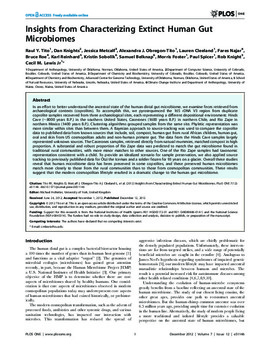| dc.contributor.author | Raul Y. Tito | en_US |
| dc.contributor.author | Dan Knights | en_US |
| dc.contributor.author | Jessica Metcalf | en_US |
| dc.contributor.author | Alexandra J. Obregon-Tito | en_US |
| dc.contributor.author | Lauren Cleeland | en_US |
| dc.contributor.author | Fares Najar | en_US |
| dc.contributor.author | Bruce Roe | en_US |
| dc.contributor.author | Karl Reinhard | en_US |
| dc.contributor.author | Kristin Sobolik | en_US |
| dc.contributor.author | Samuel Belknap | en_US |
| dc.contributor.author | Morris Foster | en_US |
| dc.contributor.author | Paul Spicer | en_US |
| dc.contributor.author | Rob Knight | en_US |
| dc.contributor.author | Cecil M. Lewis Jr | en_US |
| dc.date.accessioned | 2015-01-23T17:17:41Z | |
| dc.date.accessioned | 2016-03-30T15:35:38Z | |
| dc.date.available | 2015-01-23T17:17:41Z | |
| dc.date.available | 2016-03-30T15:35:38Z | |
| dc.date.issued | 2012-12-12 | en_US |
| dc.identifier.citation | Tito RY, Knights D, Metcalf J, Obregon-Tito AJ, Cleeland L, et al. (2012) Insights from Characterizing Extinct Human Gut Microbiomes. PLoS ONE 7(12): e51146. doi:10.1371/journal.pone.0051146 | en_US |
| dc.identifier.uri | https://hdl.handle.net/11244/14084 | |
| dc.description | We are deeply grateful to Art Aufderheide, now retired, who provided samples and contextual information from Caserones. | en_US |
| dc.description | Provided contributions to drafts of the manuscript including edits, comments, and/or figures and tables: RYT DK JM AJOT LC FN BR KR KS SB MF PS RK CML. Conceived and designed the experiments: RYT DK RK CML. Performed the experiments: RYT DK AJOT LC JM. Analyzed the data: RYT DK RK CML. Contributed reagents/materials/analysis tools: FN BR KR KS SB RK MF PS CML. Wrote the paper: RYT CML. | en_US |
| dc.description.abstract | In an effort to better understand the ancestral state of the human distal gut microbiome, we examine feces retrieved from archaeological contexts (coprolites). To accomplish this, we pyrosequenced the 16S rDNA V3 region from duplicate coprolite samples recovered from three archaeological sites, each representing a different depositional environment: Hinds Cave (∼8000 years B.P.) in the southern United States, Caserones (1600 years B.P.) in northern Chile, and Rio Zape in northern Mexico (1400 years B.P.). Clustering algorithms grouped samples from the same site. Phyletic representation was more similar within sites than between them. A Bayesian approach to source-tracking was used to compare the coprolite data to published data from known sources that include, soil, compost, human gut from rural African children, human gut, oral and skin from US cosmopolitan adults and non-human primate gut. The data from the Hinds Cave samples largely represented unknown sources. The Caserones samples, retrieved directly from natural mummies, matched compost in high proportion. A substantial and robust proportion of Rio Zape data was predicted to match the gut microbiome found in traditional rural communities, with more minor matches to other sources. One of the Rio Zape samples had taxonomic representation consistent with a child. To provide an idealized scenario for sample preservation, we also applied source tracking to previously published data for Ötzi the Iceman and a soldier frozen for 93 years on a glacier. Overall these studies reveal that human microbiome data has been preserved in some coprolites, and these preserved human microbiomes match more closely to those from the rural communities than to those from cosmopolitan communities. These results suggest that the modern cosmopolitan lifestyle resulted in a dramatic change to the human gut microbiome. | en_US |
| dc.language.iso | en_US | en_US |
| dc.publisher | PLos One | en_US |
| dc.relation.ispartofseries | PLoS ONE 7(12):e51146 | en_US |
| dc.relation.uri | http://www.plosone.org/article/info%3Adoi%2F10.1371%2Fjournal.pone.0051146 | en_US |
| dc.rights | Attribution 3.0 United States | en_US |
| dc.rights.uri | https://creativecommons.org/licenses/by/3.0/us/ | en_US |
| dc.subject | PLOS | en_US |
| dc.subject | Public Library of Science | en_US |
| dc.subject | Open Access | en_US |
| dc.subject | Open-Access | en_US |
| dc.subject | Science | en_US |
| dc.subject | Medicine | en_US |
| dc.subject | Biology | en_US |
| dc.subject | Research | en_US |
| dc.subject | Peer-review | en_US |
| dc.subject | Inclusive | en_US |
| dc.subject | Interdisciplinary | en_US |
| dc.subject | Ante-disciplinary | en_US |
| dc.subject | Physics | en_US |
| dc.subject | Chemistry | en_US |
| dc.subject | Engineering | en_US |
| dc.title | Insights from Characterizing Extinct Human Gut Microbiomes | en_US |
| dc.type | Research Article | en_US |
| dc.description.peerreview | Yes | en_US |
| dc.description.peerreviewnotes | http://www.plosone.org/static/editorial#peer | en_US |
| dc.identifier.doi | 10.1371/journal.pone.0051146 | en_US |
| dc.rights.requestable | false | en_US |

